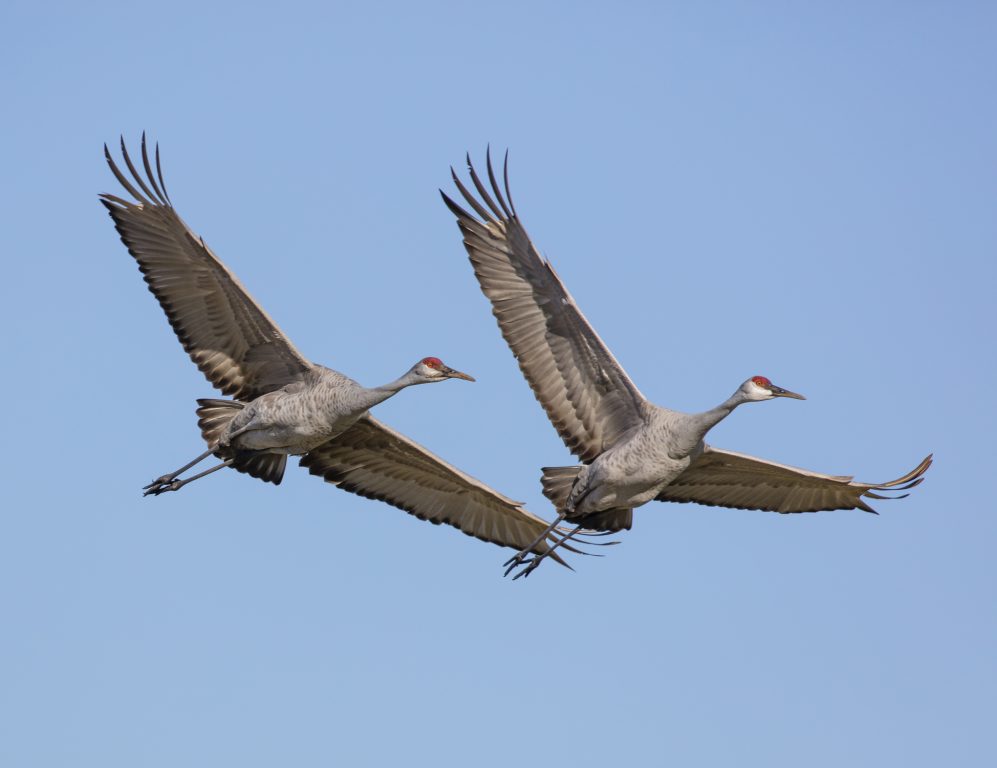Committee Will Study Possible Wisconsin Sandhill Crane Hunt
A legislative committee will recommend proposals for managing the population of sandhill cranes and their impacts on farms
A committee of lawmakers, conservationists and farmers met for the first time Thursday to study ways to manage Wisconsin’s growing population of sandhill cranes.
The eastern population of sandhill cranes, which includes Wisconsin, has rebounded after nearly being hunted to extinction in the late 1800s. The most recent count last fall observed more than 110,000 birds, according to the Wisconsin Department of Natural Resources.
As the population expands, cranes have caused crop losses on some Wisconsin farms. That prompted Republican lawmakers to put a bill forward in 2021 that would allow hunting of sandhill cranes, but the bill failed to advance in the Legislature. Rep. Paul Tittl, R-Manitowoc, introduced the proposal in the Assembly and serves as chair of the study committee.
“We are not trying to do any certain outcome on this, but we want to study the sandhill cranes and their tremendous success here in Wisconsin,” Tittl said. “They have come back from the early 1900s from almost nothing. I think that’s important, and we entrust the DNR to manage our game.”
The Joint Legislative Council study committee is made up of 12 members. They include lawmakers from both political parties and representatives of the International Crane Foundation, Wisconsin Corn Growers Association and Wisconsin Waterfowl Association.
The committee will recommend legislation for managing the sandhill crane population and addressing their impact on farms.
Wisconsin farmers and growers report crop losses due to the birds
The state counts an average of 50,000 sandhill cranes each year, according to Taylor Finger, the DNR’s migratory game bird ecologist. The most recent survey shows the eastern population grew about 19 percent in 2022 compared to the previous year.
“We do have the habitat available. We do have the food available. We’re not hunting them. It’s a perfect scenario for these birds to thrive in,” Finger said.
North America is host to more than 1.4 million sandhill cranes, but some subspecies are endangered. The eastern population primarily breeds and nests across the Great Lakes region in Wisconsin, Michigan and Ontario. The birds have challenged farmers by eating seedlings, leading to crop losses.
Finger said the Wildlife Services program within the U.S. Department of Agriculture typically receives around 180 complaints from farms in Wisconsin stemming from damage to corn, wheat and potatoes. Corn growers have reported around $900,000 to $1 million worth of damage each year to the DNR. Under state law, farmers are unable to receive payments for crop damage through the state’s wildlife damage abatement program unless the DNR authorizes a hunt.
David Mickelson, a farmer from DeForest on the committee, said he’s used the seed treatment avipel to ward off birds on his farm.
“A couple of weeks ago, we finished our wheat harvest. Since then, we’ve had probably a couple hundred (sandhill cranes) cleaning up the leftover wheat in the field,” said Mickelson.
The Fish and Wildlife Service issues about 200 permits in Wisconsin annually to kill between 1,100 to 1,200 sandhill cranes that create problems for farms. The DNR said Ojibwe tribes also harvest several hundred sandhill cranes each year across ceded territory.
Rep. Dave Considine, D-Baraboo, said he wants to ensure that both cranes and farmers thrive.
“That’s what I want this committee to do is to come up with a way that both can thrive and coexist,” Considine said.
Tamas Houlihan with the Wisconsin Potato and Vegetable Growers Association agreed that there has to be a balance between “preserving the environment and being able to farm.”
Former DNR official says a hunt may not help farmers
The species is currently hunted across 18 states and three Canadian provinces. A 2010 management plan developed by the Mississippi and Atlantic Flyway Councils calls for a potential crane hunt once their numbers exceed a range between 30,000 to 60,000 birds. Within the eastern population, hunters killed 1,085 birds during the 2022-2023 season across Kentucky, Alabama and Tennessee, a 30 percent increase from the prior year.
In Wisconsin, only 17 percent of 2,769 people surveyed last December support a hunting season on sandhill cranes. That’s according to a study led by researchers at the University of Wisconsin-Madison and funded by the International Crane Foundation. The organization has said crop damage by cranes should be solved by other means, saying a hunt wouldn’t have any significant benefit for farmers.
Anne Lacy with the International Crane Foundation added that its study of cranes in Briggsville shows that reproduction is likely slowing as the population grows.
“The recovery of the Sandhill crane in part is due to their ability to adapt to an agricultural landscape. The fledging success, however, may be declining in Wisconsin, especially in those agricultural areas,” Lacy said. “They’re still in the process of reestablishing their former range.”
Ken Van Horn served on the committee that developed the regional management plan for sandhill cranes. Van Horn, a former DNR migratory game bird ecologist, said the population has continued to grow despite removal of problem birds. Even so, he said the state wouldn’t be able to develop a hunt that drives the population down under the plan’s current framework.
“We’re just not. It’s structured to be sustainable, so you’re not going to lower the population in Wisconsin by adding a hunting season,” Van Horn said.
He said that’s due to requirements that restrict any hunt to the fall to avoid killing birds while they’re nesting in the spring. He noted sandhill cranes in Wisconsin are already being hunted when they migrate to other states like Kentucky, Tennessee or Alabama.
The committee will hold additional meetings and make recommendations by the beginning of the next legislative session in January.
Should Wisconsin hold a sandhill crane hunt? A committee will study that and more. was originally published by Wisconsin Public Radio.
If you think stories like this are important, become a member of Urban Milwaukee and help support real, independent journalism. Plus you get some cool added benefits.






















